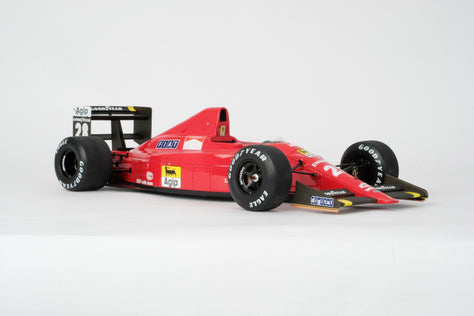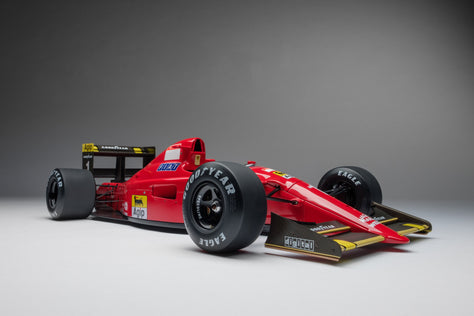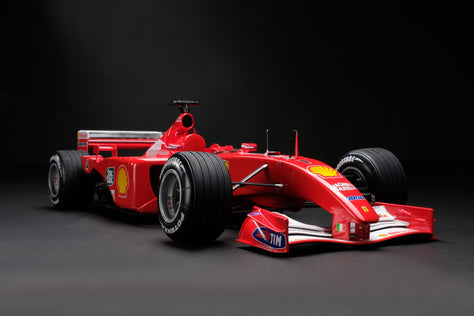技术详情
- 简介
- 比例指南
Originally known as its designated project number 640, the Ferrari F1-89 was Ferrari’s entry into the 1989 FIA Formula One World Championship. Driven by future World Champion Nigel Mansell and Gerhard Berger, the F1-89 was the first Ferrari chiefly conceived by innovative British designer John Barnard. Complicated technology and communications difficulties with Barnard, who was working from England at the time, dragged out the car’s development. However, when it finally did emerge, it was seen by the other constructors, thanks to its incredible pace and extremely clean-looking form, as a shining example of superb engineering and aerodynamics. The F1-89 was powered by a naturally aspirated 65-degree V12 cylinder engine, with 600 bhp at 12,000 rpm, and sported a sharp nose, with a narrow monocoque and bulging side-pods designed to house the radiators with maximum aerodynamic efficiency. With innovative aerodynamics and pushrod suspension with torsion bars instead of the classic coil springs, the F1-89 was fitted with a revolutionary semi-automatic gearbox, activated by the driver on the steering wheel. The semi-automatic gearbox was Barnard’s solution to the problem of the long manual actuation mechanism, but it was Ferrari who had pioneered this technology a decade earlier, eventually postponing the project due to a lack of advanced electronics at the time. Though the gearbox proved to be unreliable during the season, hampering Ferrari’s efforts, it more than proved its worth, and such gearboxes would become the norm by the mid-1990s.
Nigel Mansell, personally selected by Enzo Ferrari, joined the Scuderia for the 1989 season, partnering with Gerhard Berger. ‘Il Leone’ made a quick impression, winning the season-opening race in Brazil. The potential of the car was clear; on outright pace alone, the F1-89 was a leader. However, the reliability of the new technology soon proved to be the major concern for Ferrari and neither driver would see the chequered flag until the French Grand Prix six races later. There were to be no races in which both drivers finished, as the F1-89 suffered nineteen retirements from a possible thirty, including five double retirements, and yet, when the F1-89 reached the chequered flag, it never failed to finish on the podium. Mansell would win again in Hungary, as well achieving as second place finishes in the French and British Grand Prix and third places in Germany and Belgium. Berger only managed to finish three races all season, winning in Portugal and achieving second place finishes in Italy and Spain. Despite the poor reliability, the F1-89 would earn 59 points towards the Constructors’ Championship, allowing Ferrari to claim third place behind McLaren and Williams.
This 1:18 scale model is of the Ferrari F1-89 as raced by Nigel Mansell and Gerhard Berger during the XLII Shell British Grand Prix at Silverstone Circuit on the 16th of July 1989. Mansell qualified in third at Silverstone with Berger in fourth, behind the McLarens of Ayrton Senna and Alain Prost. The Ferrari duo started the race cleanly, letting their main rivals battle into the first corner. Berger pulled into the pits with electrical issues, rejoining the race several laps later. Senna span into the gravel on the entry to Becketts on lap 12, due to gear selection issues, promoting Prost into the lead and Mansell into second. The leading pair extended their lead over the rest of the field, Prost maintaining a slim advantage over the British racer. On lap 42, Mansell developed a puncture on his front right tyre, forcing him to pit, handing full advantage to the Frenchman. Prost was delayed on his own scheduled pit stop but returned to the track with a healthy lead over Mansell. Prost reached the chequered flag 19 seconds ahead of Mansell, with a further 29 second gap to the Benetton of Alessandro Nannini completing the podium. Berger ultimately retired on lap 49 with a mechanical issue.
Many of the 1:18 scale projects we create at Amalgam Collection take advantage of the previous intense research and development process we have been through to create our 1:8 scale model of the same car. Working from the same CAD data supplied directly by Scuderia Ferrari, our engineers fabricated a pattern for each component of the model. The master patterns were created for each piece of the complex assembly using 3D printing and meticulous hand finishing. Moulds are then taken from each pattern and used to create a small batch of precisely engineered cast components, each one fettled and fitted to make a complete set, before painting, finishing and assembly. The resulting prototype model only receives the approval of the designers, engineers and historians at Gestione Sportiva once they were fully satisfied with its accuracy of representation. This stunningly detailed and precise scale replica, handcrafted and finished in our workshops, is the final result.
Note: This is a 'Kerbside' model and does not any feature moving parts.
预订
定制款
In order for us to create your bespoke model, you will need to choose 4 extra options. Paint colour, interior colour, wheel style and caliper colour.
Please complete the form and a member of our Sales Team will contact you.
联系我们
请与我们联系以获取有关订购此型号的更多信息。







